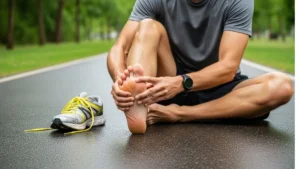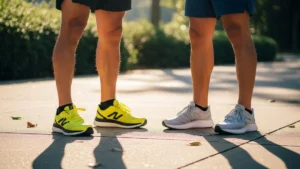
Running doesn’t stop when you do. Your body’s just getting started with the part that actually matters—recovery. Most runners don’t ask for advice before they run. They start asking when the soreness kicks in and walking downstairs becomes a chore. So let’s get right to it.
Real Questions Runners Ask After a Run
Why do my legs feel sore hours later?
Your legs feel sore later because of microtears in the muscle tissue. These tears happen from the impact and load during your run, and the soreness—also called DOMS—sets in after a few hours. It’s your body’s way of repairing and adapting to stress.
That dull ache in your thighs or calves? It’s common, especially after speed work or long runs. It usually peaks around 24–48 hours after the workout. DOMS (Delayed Onset Muscle Soreness) isn’t a sign that you did something wrong. It’s normal. But how you treat it will decide how ready you are for your next run.
Should I eat right after running or wait?
You should eat within 30–60 minutes after running. This is when your muscles absorb nutrients best, helping you recover faster and reduce fatigue. Aim for a mix of protein and carbs.
Think of it as “recharging your battery.” If you miss this window, you’ll feel drained later—even if you don’t notice it right away. A banana and peanut butter, chocolate milk, eggs on toast—anything that combines fast carbs with protein will help restock glycogen and start muscle repair.
Do I really need to stretch every time?
Yes. Light stretching after a run helps reduce tightness and keeps your muscles flexible. It’s not about preventing injury immediately, but about staying mobile and running better over time.
You don’t need a yoga mat and 45 minutes. Five minutes of hamstring, quad, and calf stretches can make a big difference. Skipping stretching once won’t ruin you. Skipping it all the time? That’s when problems creep in. Tight hips, limited stride, and nagging pain—most of it builds up quietly.
How can I recover faster without expensive gear?
You can recover faster using just water, food, sleep, and movement. Tools help, but they’re not essential. The basics do more than the gadgets.
Don’t buy a $300 massage gun if you’re not sleeping enough or eating poorly. You can use a tennis ball, a frozen water bottle, or your own bodyweight for most recovery techniques. Drink water. Eat real food. Walk the day after a hard run. Stretch a little. Sleep 7–9 hours. These don’t cost you a cent, and they work.
Anecdote: I once trained for a half-marathon using nothing but a foam roller and cold showers for recovery. I beat my PR by 6 minutes.
What’s Happening to Your Body After a Run?
Microtears, inflammation, and muscle fatigue
Running causes tiny muscle tears, builds up inflammation, and drains your energy stores. This is normal. It’s how your body gets stronger—if you let it recover.
Every time your foot hits the ground, your muscles absorb impact. That stress causes microtears—especially in your quads, calves, and hamstrings. In response, your body sends blood to the area, which triggers swelling and inflammation. That’s not a bad thing. It’s just part of the repair process.
But here’s the catch: if you run again before those fibers heal, you’re layering damage on top of damage. That’s how fatigue sticks around, or worse, injuries happen.
What Users Say’s about The Running Post
“Thanks for sharing this on TheRunningPost! I’ve been running regularly for a year but still find recovery a huge challenge after longer runs. I also delay foam rolling because of the pain, but now I realize I’m not alone. I’d be curious to see a follow-up post with tips on how to make early recovery more bearable—maybe some gentle alternatives to foam rolling?” by (Mautause).
Why skipping recovery sets you back
Skipping recovery keeps your muscles in a constant state of stress. Instead of adapting, they break down—and your performance stalls.
If your legs always feel heavy or slow, it’s not your fitness. It’s poor recovery. Every run is a stress signal. Recovery is the reply. Without the reply, your body gets confused—and eventually, it stops progressing.
You’ll notice things like slower pace, mood dips, higher resting heart rate, or even disrupted sleep. These are all signs your recovery is falling short.
Anecdote: A 10K runner I trained with once plateaued for 3 months. Turned out, she hadn’t taken a proper rest day in over 6 weeks. Two full rest days and a sleep schedule later? She dropped her time by 90 seconds.
The 24-hour window that matters most
Your first 24 hours after a run decide how strong you feel on your next one. What you eat, drink, and how you rest during this time matters more than any recovery tool.
Right after a run, your body is more responsive to help. Muscles are primed to absorb protein. Cells are ready to refill energy stores. Stretching feels better. Circulation is up. If you wait too long, that window closes and healing slows down. Think of it like patching a roof. Do it while the sun’s out, and it’s easy. Wait until the rain hits again, and now you’ve got a problem.
12 Simple Habits That Speed Up Recovery
Drink water before anything else
Water replaces what you lost through sweat. If you don’t rehydrate, your muscles stay tight, your heart works harder, and recovery takes longer.
Before you reach for food or supplements, grab a glass of water. Even mild dehydration delays healing and increases soreness. Aim for plain water, not sugary drinks.
Eat protein and carbs within 30 minutes
Your body absorbs nutrients best right after your run. Protein repairs muscle. Carbs refill your energy. Don’t skip this.
This isn’t about giant meals. A simple snack like yogurt and fruit, or a boiled egg with toast, gets the job done. It primes your body to recover well.
Use gentle stretching instead of skipping it
Stretching helps release tightness and keep your muscles moving well. It’s not about flexibility—it’s about staying loose.
Stick to static stretches after your run. Focus on hamstrings, quads, calves, and hip flexors. Don’t push hard. The goal isn’t to become bendy. Just keep things from locking up.
Foam rolling (cheap and effective)
Foam rolling increases blood flow, breaks up tight spots, and helps muscles recover faster—without spending much.
You don’t need fancy moves. Roll slowly over your quads, IT bands, calves, and glutes. Pause on sore spots, breathe through it. A few minutes can make your legs feel fresh again.
Sleep like your race depends on it
Sleep is the best recovery tool you have. Muscle repair, hormone balance, and energy rebuild happen while you’re out cold.
Aim for 7–9 hours. If you’re training hard, you may need more. No app, powder, or massage gun can make up for poor sleep.
Use compression gear if soreness lingers
Compression gear helps blood flow and may ease soreness, especially after longer runs. It’s not magic—but it helps.
Try socks or sleeves after intense workouts or races. Wear them for a few hours, especially while resting or walking around.
Active rest beats total rest
Movement helps flush soreness out faster than sitting still. Walk, stretch, or do light mobility work.
You’re not aiming for effort—just circulation. The worst thing you can do after a hard run is nothing at all. Think gentle, not lazy.
Cold showers or baths: do they help?
Cold water reduces inflammation and dulls soreness. It’s not essential—but many runners swear by it.
If you feel extra sore or swollen, try a 5–10 minute cold rinse or ice bath. Don’t overdo it. And don’t skip sleep or food thinking this replaces them.
Magnesium and salt for cramps
Cramps often come from lost electrolytes. Magnesium, sodium, and potassium help bring muscles back into balance.
You don’t always need supplements. Bananas, leafy greens, nuts, and a pinch of salt in your water can help. If cramps are common, check your diet first.
Lay off the alcohol after running
Alcohol slows muscle repair, dehydrates you, and interrupts sleep. Not worth it after a hard workout.
One drink might not ruin you. But several? They delay everything your body’s trying to do right. Save it for your rest day—after you’ve recovered.
Cross-train on recovery days
Cross-training keeps you fit without overloading the same muscles. It helps your body stay fresh.
Think swimming, cycling, yoga, or walking. These don’t hit the joints or strain your legs the same way running does. But they keep your blood flowing and heart rate moving.
Don’t ignore your shoes
Old or worn-out shoes mess with your form and increase soreness. They’re a silent recovery killer.
Check your soles. If they’re uneven or smooth, it’s time to switch. Rotate pairs if you run often. Your legs absorb less shock with good shoes, which means faster recovery.
When Should You Rest—and When Should You Run Again?
Listen to your legs, not just your calendar
You should rest when your legs feel heavy, tight, or unresponsive—even if your schedule says “run.” Your body doesn’t care what the calendar says.
Training plans help, but they don’t know how you feel. If your legs aren’t bouncing back or your heart rate stays high during easy runs, take a day off. Rest isn’t weakness—it’s strategy.
Anecdote: One runner I knew followed her 12-week plan to the letter. She skipped rest days even when sore. By week 8, she was benched with shin splints. All that progress? Wasted.
Warning signs of poor recovery
If you’re always sore, unusually tired, or losing motivation, your body’s not keeping up. These are signs to back off.
Other red flags: bad sleep, mood swings, slow pace on easy runs, or catching colds often. These signs mean your body’s working too hard to repair itself. Add rest, not more miles.
How often to run if you’re training seriously
Most serious runners train 4–6 days a week, but they rotate intensity and allow for full rest or recovery days.
You don’t need to run every day to get better. In fact, the fastest runners often rest more strategically than beginners. Quality beats quantity. Easy runs, long runs, and rest days should balance each other out.
Tools That Actually Help (and Ones That Don’t)
Foam rollers, massage guns, and lacrosse balls
Foam rollers, massage guns, and lacrosse balls all help loosen tight muscles and improve circulation—if you use them right. But they’re not miracle fixes.
These tools can reduce soreness and improve mobility, especially after tough runs. But they don’t replace food, sleep, or time. If you’re using them instead of resting, you’re doing it wrong. Use them with recovery, not instead of it.
Elevation and legs-up-the-wall trick
Putting your legs up after a run helps blood flow return, reduces swelling, and feels good—no gear needed.
This trick is free, simple, and useful—especially after long runs. Just lie down, legs straight up against a wall for 10–15 minutes. It helps drain fluid from your legs and lowers heart rate quicker.
Anecdote: I started doing this after long Sunday runs. It became a ritual—felt weird at first, but after two weeks I noticed less swelling and faster bounce-back.
Are supplements necessary?
Supplements aren’t required for recovery. Most runners get what they need from food, sleep, and hydration. Use them only if you’ve got gaps in your diet.
Protein powders, magnesium, or electrolyte drinks can help—but they’re extras. Not everyone needs them. If your meals are balanced and you’re recovering well, don’t overthink it.
Sample Post-Run Recovery Routine You Can Follow Today
You don’t need an expensive plan—just timing, fuel, and smart movement. Recovery starts the moment you stop running. Follow this four-part routine to reduce soreness, protect your muscles, and bounce back stronger for your next session.
0–10 minutes after a run
Walk, breathe, and hydrate—don’t just collapse.
Your body’s still in high gear. Slow to a walk for 5 minutes, then do light stretching to help flush out lactic acid. Drink water or an electrolyte drink to start replacing what you lost. This small window sets the tone for your recovery.
30–90 minutes post-run
Eat real food—especially carbs and protein.
This is your refueling window. Aim for a 3:1 ratio of carbs to protein (like rice and chicken or a smoothie with banana and whey). This helps muscle repair and restocks glycogen stores. Avoid processed junk—it slows the recovery process.
Evening wind-down for deeper recovery
Stretch, elevate, and sleep well.
Use a foam roller or massage ball before bed to release tight spots. Try the legs-up-the-wall pose for 10 minutes to boost circulation. Then unplug early—deep sleep is when muscles rebuild. No screen time, no caffeine..
Next day low-impact movement
Don’t be a statue—move, gently.
Even on a rest day, keep blood flowing. Go for a light walk, an easy bike ride, or do yoga. This reduces stiffness and keeps your legs fresh. If you’re limping or still wiped out, skip it and rest fully.
Include These Recovery Foods in Your Rotation
What you eat after a run matters as much as the run itself. The right foods rebuild muscle, reduce inflammation, and refill your tank. From breakfast to bedtime, fueling smart can cut recovery time in half and leave you feeling stronger, not sore.
Best post-run breakfast
Refuel with protein, carbs, and color.
Try scrambled eggs with avocado toast and berries, or oatmeal with almond butter and banana. You want muscle-repairing protein and energy-restoring carbs, plus antioxidants from fruit to fight inflammation. Skip sugary cereals—they spike then crash your energy.
Midday snacks that work
Smart snacks keep the recovery going.
Greek yogurt with honey, cottage cheese and pineapple, or a handful of trail mix deliver protein, healthy fats, and nutrients. Avoid chips or protein bars with long ingredient lists—they often slow digestion and offer little real value.
Meals that reduce soreness
Think lean, anti-inflammatory, and colorful.
Salmon with quinoa and roasted vegetables is a gold standard. Chicken stir-fry with greens and turmeric rice is another. Aim for whole foods rich in omega-3s, antioxidants, and complex carbs. The brighter your plate, the better your recovery.
Drinks that help (and ones that don’t)
Hydration speeds healing—if you drink the right stuff.
Water is essential, but low-sugar electrolyte drinks or coconut water help too. Tart cherry juice or turmeric lattes can reduce muscle soreness. Avoid soda, too much coffee, and alcohol—they dehydrate and disrupt sleep, both recovery killers.
Extra Tips for Long-Distance or Marathon Runners
Running longer distances demands smarter recovery. You can’t just wing it. Long runs create deeper muscle breakdown, stress your nervous system, and tax your immune response. Structured recovery—before and after races—can be the difference between a personal best and burnout.
Don’t treat every run the same
The longer the run, the more intentional your recovery should be.
Easy 5K? Light stretch and hydration might do. But a 20-miler? That requires carbs within 30 minutes, serious rest, and soft tissue work. Understand your mileage and effort level so your recovery matches the stress you’ve placed on your body.
Why recovery needs planning, not guessing
Hope isn’t a strategy—especially in marathon prep.
Map out your recovery like you map your training: schedule rest days, know your fueling needs, and keep track of soreness and sleep. Recovery isn’t passive—it’s a performance tool. Use logs, checklists, and post-run routines to stay on track.
Tapering and recovery after races
Taper smart, recover smarter.
Don’t wait until race day to think about healing. Tapering reduces training load gradually to allow your body to store energy and repair. Post-race, expect 1–2 weeks of easy movement, sleep focus, and nutrient-rich meals. You’ve earned the rest—take it seriously.
How to Know Your Recovery Plan Is Working
Your body gives feedback—learn to listen.
A good recovery plan leaves you energized, not exhausted. If your runs feel smoother, soreness fades faster, and injuries decrease, your system is working. When you wake up feeling ready instead of wrecked, you’re recovering right.
Your resting heart rate is steady
Use your pulse as a reliable recovery gauge.
Track your resting heart rate each morning. If it stays stable or drops slightly, your body is adapting well. A sudden spike could mean you’re overtraining or under-recovering. Use apps or smartwatches for easy daily tracking.
You don’t dread your next run
Recovery builds excitement, not burnout.
Mental fatigue is a red flag. If your recovery is on track, you’ll look forward to training. But if each session feels like a chore, your body may be asking for more rest or better fueling.
You’re seeing gains, not injuries
Progress equals smart recovery.
Noticeable improvements in pace, endurance, or reduced soreness are signs your body is absorbing the training load. Frequent small injuries or lingering stiffness indicate recovery gaps that need fixing.
Your sleep and mood improve
Restoration shows up in the little things.
Quality sleep, better focus, and an upbeat mood are often overlooked markers of proper recovery. If you’re snappy or struggling to sleep, it could be time to adjust your post-run habits.
Where to Use Data
Study: Protein intake and muscle repair
Cite science to support protein timing.
Refer to peer-reviewed studies showing how 20–30 grams of protein within 30 minutes post-run can significantly enhance muscle recovery. Link to sources like the Journal of the International Society of Sports Nutrition or PubMed to validate your content.
Stat: Percentage of runners who skip recovery
Hook readers with a revealing stat.
Open with a stat like “Nearly 60% of amateur runners admit they skip structured recovery” (Runner’s World survey, 2023). Use this to emphasize why the article matters and to immediately connect with the reader’s likely habits.
Quote from sports medicine expert
Add credibility through voice.
Include a quote from a certified expert, such as:
“Recovery isn’t optional—it’s training in disguise.”
Dr. Lisa Hartman, Sports Medicine Specialist
A direct quote adds human authority and breaks up your article visually.
Link to muscle soreness recovery time chart
Visualize what recovery looks like.
Use a chart that shows average DOMS (Delayed Onset Muscle Soreness) timelines—e.g., peak soreness at 24–72 hours post-run. Link to medical or athletic training sources. This gives your readers realistic expectations and timing for when they’ll feel better.






